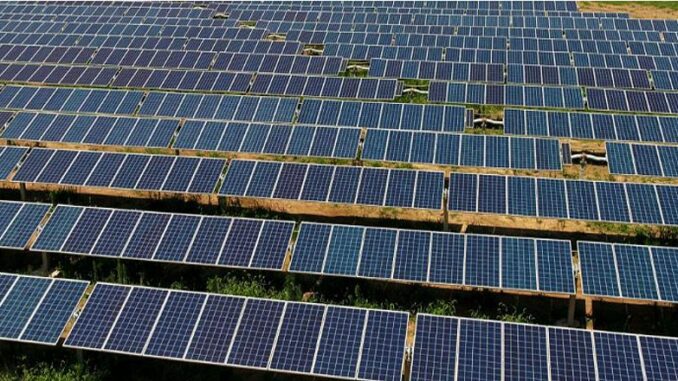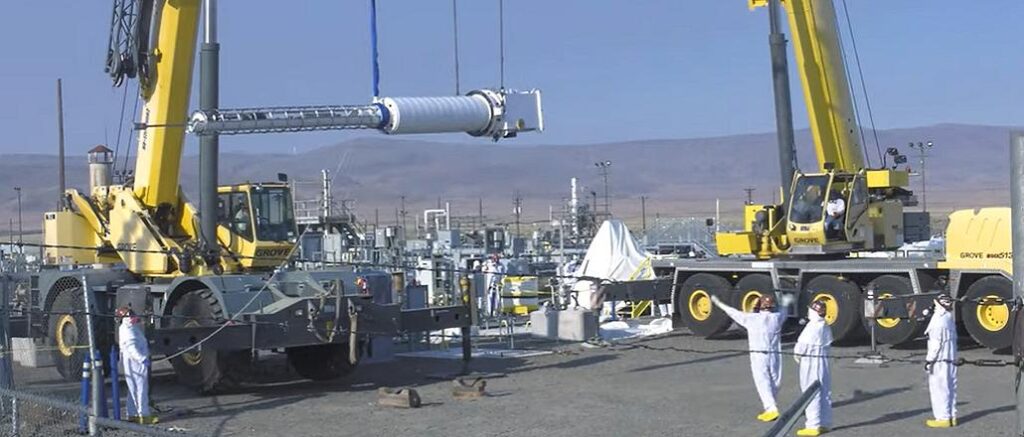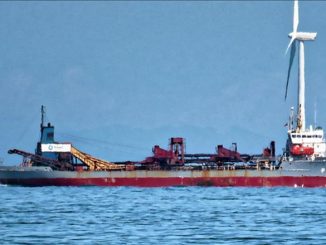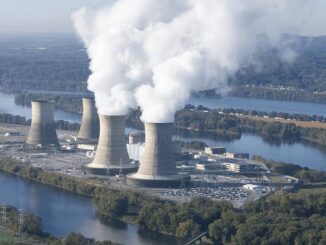
RICHLAND, Washington, August 6, 2024 (ENS) – The U.S. Department of Energy is entering negotiations with a Chicago corporation to build one of the largest solar and battery storage energy projects in the nation at the site where plutonium-powered nuclear weapons for the Cold War were made – the Hanford site in southeastern Washington.
“Since the beginning of the Biden-Harris Administration, we’ve added nearly 90 gigawatts of solar capacity to the grid – enough to power roughly 13 million homes – and we’re building on this historic progress with another massive solar project,” said Energy Secretary Jennifer Granholm.
“With today’s announcement, DOE is transforming thousands of acres of land at our Hanford site into a thriving center of carbon-free solar power generation, leading by example in cleaning up our environment and delivering new economic opportunities to local communities,” said Secretary Granholm.
The Energy Department announced Thursday that it has chosen Hecate Energy based in Chicago, Illinois, for a gigawatt-scale project on up to 8,000 acres of unused nuclear reservation land near the southeastern edge of the Hanford site. About 14,000 acres in Hanford’s southeast corner are proposed for clean energy production leasing.
Formerly called the Hanford Nuclear Reservation, the decommissioned nuclear production complex occupies more than 500 square miles of land on the Columbia River, about 200 miles (322 kilometers) southeast of Seattle. It is operated by the U.S. federal government.
For nearly 30 years, the U.S. Department of Defense and the Department of Energy produced tons of plutonium for use in the U.S. atomic weapons program. Activities at Hanford produced waste hazardous chemicals and radioactive materials, including 56 million gallons (212 million liters) of radioactive waste stored in underground tanks. Some of these contaminants have leaked into the land and water, including into the Columbia River.
The nuclear reactors, first constructed as part of the top-secret Manhattan Project during World War II, required huge amounts of water to keep the cores cool. Chromium compounds added to keep the equipment from corroding have entered the river, ruining fish and wildlife habitat.
Now the site employs about 11,000 people for environmental cleanup and maintenance of the site at the cost of about $3 billion annually.
Today, in addition to extensive cleanup operations, Hanford is the site of the only operating nuclear power plant in the Pacific Northwest, the Columbia Generating Station operated by Energy Northwest. It generates about 1.2 gigawatts of baseload power, roughly 10 percent of the electricity used in the state of Washington.
Energy Northwest, a Washington state joint operating agency, owns and operates a portfolio of clean energy projects, including hydroelectric, solar, wind, battery storage and nuclear energy facilities.
The solar project could be operating in five to seven years. It would be the largest project in the Department of Energy’s Cleanup to Clean Energy initiative announced in July 2023. This program repurposes parts of DOE-owned land, including lands previously used in the nation’s nuclear weapons program, for clean energy projects.
“We are going to transform the lands we have used over decades for nuclear security and environmental remediation by working closely with tribes and local communities together with partners in the private sector to build some of the largest clean energy projects in the world,” said Secretary Granholm. “Through the Cleanup to Clean Energy initiative, DOE will leverage areas that were previously used to protect our national security and will repurpose them to the same end—this time, generating clean energy that will help save the planet and protect our energy independence.”
DOE’s Office of Environmental Management, Office of Nuclear Energy, and National Nuclear Security Administration have identified about 70,000 acres for potential development at five sites:
- Hanford Site, Richland, Washington
- Idaho National Laboratory, Idaho Falls, Idaho
- Nevada National Security Site, Nye County, Nevada
- Savannah River Site, Aiken, South Carolina
- Waste Isolation Pilot Plant, Carlsbad, New Mexico
Expanding clean energy generation creates good-paying jobs, protects the environment and supports healthier communities across the country, said Brenda Mallory, who chairs the White House Council on Environmental Quality.

Yet, when the Cleanup to Clean Energy Initiative was proposed, concerns were raised that a large solar project at Hanford might not be the best use of limited land planned for industrial use and to replace Hanford jobs as environmental cleanup is completed.
At Hanford up to 14,000 acres have been proposed for a clean energy park.
The Tri-City Development Council, TRIDEC, has asked that some land be reserved for its vision of an advanced clean energy park, including a north-south corridor of land that would link Hanford land transferred to the community in 2015 with land that Energy Northwest leases. That land is not included in the negotiations for the Hecate project.
“We appreciate that DOE was responsive to the community’s desire to preserve the corridor that is critically important for our Northwest Advanced Clean Energy Park vision to become a reality,” said David Reeploeg, vice president for federal programs at TRIDEC. “We have an opportunity to develop this corridor into something really special, including the innovative industries and jobs we’re looking to attract in the future.”
Situated at the confluence of the Columbia, Snake, and Yakima Rivers in southeastern Washington, the Tri-Cities are: Kennewick, with 84,000 residents the regional entertainment and retail hub, Pasco, Richland, and West Richland. The region is known for its more than 300 days of sunshine each year.
Senators Patty Murray and Maria Cantwell, both Washington Democrats, and Congressman Dan Newhouse, a Washington Republican, have worked to make sure that Secretary Granholm was aware of the Tri-Cities community’s interest in preserving land for an advanced clean energy park.

Hecate reached out to TRIDEC to discuss its plans and has pledged to partner with the Tri-Cities community to make sure the solar and battery storage project aligns with community plans for an advanced clean energy park, said Sean O’Brien, executive director of Energy Forward Alliance. The alliance will be working with Hecate to maximize the opportunities with their solar project, O’Brien said.
A clean energy hub with operating solar, hydro, wind, nuclear and energy storage facilities, the Tri-Cities region boasts thousands of employees in energy-related fields and a broad array of industry, research, education, utilities, community and Washington State leadership and support to become a clean energy model for the nation.
Regional leaders have created a business environment to help realize Washington’s clean energy future by developing solutions to both preserve and maintain existing energy sources while transitioning to reliable and affordable clean energy.
Recognizing that strong regional partnerships are needed to accomplish ambitious clean energy and carbon reduction goals, a group of regional CEOs has committed to a long-term partnership built on a shared understanding of a vision for the region, and additional investment.
Most of the 580-square-mile Hanford site is now part of the Hanford Reach National Monument or is designated for conservation once the environmental cleanup is finished.
Hecate Energy will have to wrap up its project and return the land it uses to its current condition by the time environmental cleanup at Hanford is completed, which could take some 50 years.
Eleven companies submitted proposals for clean energy projects on Hanford land; none of the other proposals under consideration is for remaining industrial land in southeast Hanford.
Hecate was picked based on its plan for the project, the plan’s technical parameters, the company’s experience and its plan to communicate with Tri-Cities area residents, tribes and other interested parties. Its proposal, along with the 10 other proposals, have not been made public.
No decision about how the solar power would be used has been made, but the Department of Energy may consider using the power right at the Hanford site.
More power would also attract new industry to the Tri-Cities. But the project would not produce baseload power that provides electricity regardless of the weather. Now most battery projects store power for a matter of hours, such as the evening hours when the sun is not shining, but not for days or weeks at a time.
Benton County has four other smaller solar projects proposed on private land and two Energy Northwest solar projects.
Hecate Energy also lists on its website a 100-megawatt solar and battery storage project as under development in Benton County, but not the location of that project. Founded in 2012, Hecate develops solar and wind power plants and energy storage projects across the United States, many of them in the southeast and along the Atlantic Seaboard. The company has projects in development to produce more than 40 gigawatts of electricity.
Editor’s Note: The “Tri-City Herald” contributed to this report.
Featured image: Hecate Energy led one of the first utility-scale solar projects completed in the Commonwealth of Virginia – handling development, financing, and construction. This project was sold to Dominion Energy at the cost of development, which was achieved in Q2 2017. (Photo courtesy Hecate Energy)
© 2024, Environment News Service. All rights reserved. Content may be quoted only with proper attribution and a direct link to the original article. Full reproduction is prohibited.



